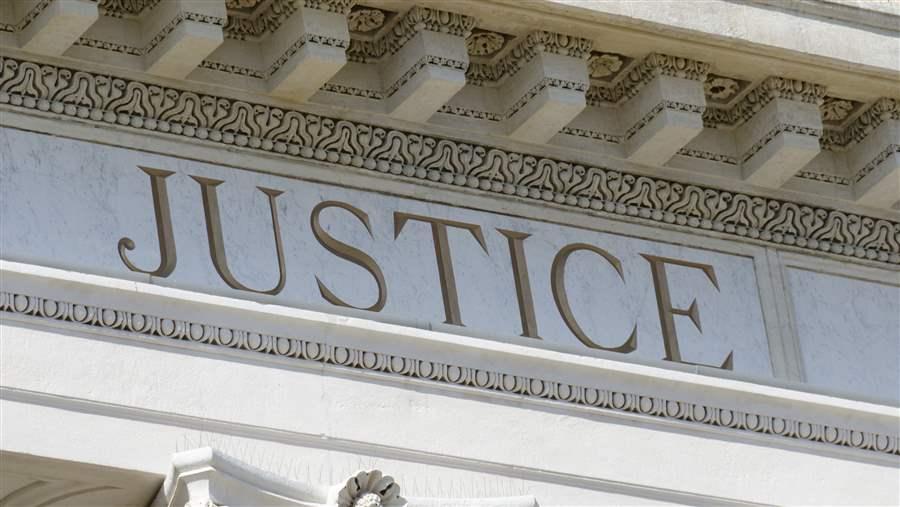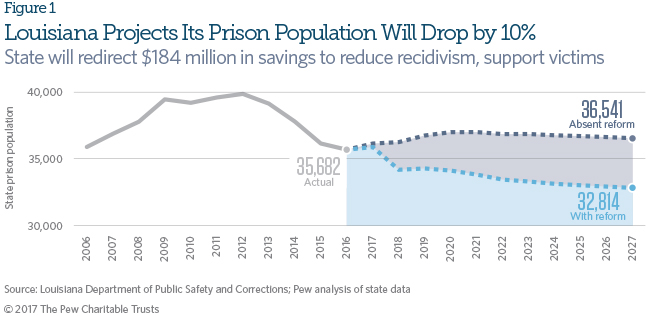Nation’s ‘Most Incarcerated State’ Chooses a New Path
Louisiana enacts landmark sentencing and corrections reforms

On June 15, 2017, Louisiana Governor John Bel Edwards (D) signed into law the most comprehensive criminal justice reform in the state’s history.1 The bipartisan package of 10 bills2 is designed to steer less serious offenders away from prison, strengthen alternatives to imprisonment, reduce prison terms for those who can be safely supervised in the community, and remove barriers to successful re-entry. The reforms should allow Louisiana to shed its status as the state with the nation’s highest imprisonment rate by the end of 2018. The state projects that the measures will reduce the prison and community supervision populations by 10 and 12 percent, respectively, over 10 years and avoid $262 million in spending.3 The state will reinvest an estimated $184 million of the savings in local programs to reduce recidivism and in services for crime victims.4 Louisiana becomes the latest state to enact such reforms; many others, including Southern states such as Georgia, Mississippi, and South Carolina, have experienced a simultaneous drop in their crime and imprisonment rates.5
I am not proud of our title as the most incarcerated state. But that’s going to be part of our history, rather than our future.Governor John Bel Edwards (D), June 15, 2017

The reforms
Six Republicans, including Senate President John A. Alario Jr.; two Democrats, including House Speaker Pro Tempore Walt Leger III; and one independent sponsored the package,6 which earned endorsements from the state District Attorneys Association,7 business and faith leaders, and diverse coalitions of advocates and community members. The bills aim to:
Focus prison space on those convicted of violent crimes
- S.B. 220 tailors sentences for drug offenses by weight, trimming penalties for possession or sale of small amounts; reduces penalties for some theft offenses; raises the felony theft threshold from $750 to $1,000; simplifies theft and burglary crimes; eliminates mandatory minimum sentences and reduces maximum sentences for several nonviolent offenses; and creates a task force to study the creation of a new felony classification system.
- S.B. 221 reduces habitual offender penalties (considered far out of step with other states) by lowering mandatory minimum sentences for those on their second or third felony convictions and eliminating life sentences for fourth and subsequent offenses when all the convictions are nonviolent.
Strengthen community supervision and implement evidence-based practices
- S.B. 139 moves up the eligibility dates for parole and good-behavior release and extends eligibility to certain inmates; authorizes administrative parole release without a hearing for nonviolent offenders (except when the victim requests or the person’s prison disciplinary record requires a hearing); authorizes increased credits for time off prison terms for participation in intensive recidivism reduction and employment programs; creates medical furlough so certain inmates can receive intensive hospital or community-based care; expands eligibility for probation and other prison alternatives; reduces the maximum probation term from five to three years; creates earned compliance credits that can reduce supervision terms by up to half for those who fulfill their conditions; caps jail time as a sanction for supervision violations at 15, 30, and 45 days for first, second, and subsequent sanctions, respectively; and expands the list of violations eligible for those sanctions.
- S.B. 16 permits most people sentenced to life as juveniles to be considered for parole after 25 years in prison.
- H.B. 116 streamlines registration for victim notification and ensures that victims can request certain safety measures as a condition of the prisoner’s release.
Remove barriers to re-entry
- H.B. 249 tailors criminal justice fines and fees to a defendant’s ability to pay; creates a payment plan for those facing financial hardship; and creates debt forgiveness for those who pay on time for 12 months or half their supervision term, whichever is longer.
- H.B. 519 simplifies the process for those with criminal convictions to apply for and receive occupational licenses.
- H.B. 680 suspends child support obligations for inmates incarcerated for more than six months.
- H.B. 681 lifts the ban on nutritional assistance and welfare benefits for people with drug convictions.
Reinvest savings
- H.B. 489 mandates the collection of data to monitor the reforms and requires that the state redirect 70 percent of savings into community-based prison alternatives, victim services, and recidivism-reduction programs in the state Department of Corrections and local jails.
The process
Louisiana’s Justice Reinvestment Task Force—a bipartisan panel of law enforcement officials, court practitioners, community members, and lawmakers—examined the state’s criminal justice system and recommended statutory and budgetary changes.8 The Pew Charitable Trusts provided nonpartisan data analysis, technical assistance, and staffing to the task force and to Gov. Edwards, legislative leaders, and bill sponsors. Pew facilitated policy discussions, helped the task force reach consensus on recommendations, engaged practitioners and stakeholder groups, drafted legislation, and educated legislators and the public on the problems the bills were designed to solve. In a letter sent after the bill signing, Gov. Edwards credited the support, analysis, and guidance from Pew as critical to the multistakeholder process.
I’ve been around and near the halls of this Capitol for 20 years now...I am not sure I have seen more impactful legislation passed. Flozell Daniels, CEO of the Foundation for Louisiana
Endnotes
- Office of Governor John Bel Edwards, “Gov. Edwards to Sign Historic Criminal Justice Reform Legislation” (video), June 15, 2017, http:// gov.louisiana.gov/index.cfm/newsroom/detail/886.
- Louisiana Department of Public Safety and Corrections, “Louisiana Justice Reinvestment Package,” http://www.doc.la.gov/media/1/Justice Reinvestment Task Force/la_final.package.summary_2017-6-7_final.pdf.
- Unless otherwise noted, information comes from the Louisiana Department of Public Safety and Corrections and from The Pew Charitable Trusts’ original analysis of Louisiana state data.
- H.B. 489, Louisiana House of Representatives, 2017 Reg. Session, http://www.legis.la.gov/legis/ViewDocument.aspx?d=1051828.
- The Pew Charitable Trusts, “National Imprisonment and Crime Rates Continue to Fall” (December 2016), http://www.pewtrusts.org/~/media/assets/2017/03/ pspp_national_imprisonment_and_crime_rates_fall.pdf.
- For a summary of the legislative package and a description of each bill, see Louisiana Department of Public Safety and Corrections, “Louisiana Justice Reinvestment Package.”
- Office of Governor John Bel Edwards, “Gov. Edwards Holds Press Conference on Criminal Justice Reform” (video), May 16, 2017, http:// gov.louisiana.gov/index.cfm/newsroom/detail/836.
- State of Louisiana, “Louisiana Justice Reinvestment Task Force Report and Recommendations” (March 16, 2017), http://www.lasc.org/documents/LA_Task_Force_Report_2017_FINAL.pdf.








